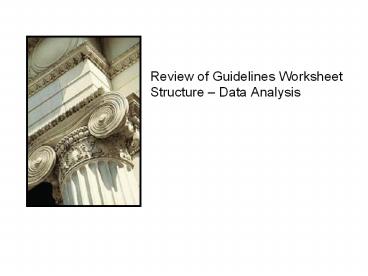Review of Guidelines Worksheet Structure - PowerPoint PPT Presentation
Title:
Review of Guidelines Worksheet Structure
Description:
Review of Guidelines Worksheet Structure Data Analysis Definition of a Prison Sentence Has Changed Current Sentencing Guidelines Structure Study Objectives Staff ... – PowerPoint PPT presentation
Number of Views:137
Avg rating:3.0/5.0
Title: Review of Guidelines Worksheet Structure
1
Review of Guidelines Worksheet Structure Data
Analysis
2
Definition of a Prison Sentence Has Changed
Abolition of parole
Prison - 1 yr. or more Jail - 12 mos. or less
Prison - 1 yr. or more Jail - 12 mos. or less
Prison - more than 6 mos. Jail - 6 mos. or less
Prison - more than 2 yrs. Jail - 2 yrs. or less
Prison - 1 yr. or more Jail - less than 1 yr.
Structure of current guidelines
policy of Virginia Department of Corrections
3
Current Sentencing Guidelines Structure
Conviction
Section A Incarceration gt 6 months Yes/No
Recommendation
No
Yes
Section C Sentence Length Recommendation
- Incarceration gt 6 months
Section B Probation or Incarceration up to 6
months Recommendation
Probation
Incarceration Up to 6 months
4
Study Objectives
- Staff is conducting exploratory analysis to
examine - the impact of the inconsistency between the
structure of the guidelines and the definition of
a prison sentence, - the differences in jail versus prison sanctioning
decisions, - the impact of nonviolent risk assessment
recommendations on sentencing decisions, and - the feasibility of simplifying the guidelines
while maintaining statistical power of the
sentencing models. This leads to a consideration
of different worksheet structures.
5
Exploration of Different Worksheet Structures
- Study the possibility of revising worksheets to
reflect current definition of a prison inmate - Section A- In/Out (Incarceration 1 Year or More)
- Section B- Prob. or Incarceration up to 12 Months
- Section C- Sentence Length (1 Year or More)
- Study the possibility of reducing the number of
worksheets from 3 to 2 - Section A- Incarceration In/Out
- Section B- Sentence Length
- Driven by historical sentencing data
6
Data Analysis
- Staff is utilizing FY1999 FY2003
Pre/Post-Sentence Investigation (PSI) data - FY2003 is complete
- Only truth-in-sentencing cases are included
- Analysis is being conducted by guidelines offense
group - First group analyzed was Schedule I/II drugs
- Make up 32 of all guidelines cases
- Disposition and sentence length vary widely by
primary offense
7
FY1999-2003 Drug Schedule I/II PSI Cases Analyzed
Primary Offense Number Percent Incarceration Rate (Pct)
Possession/1st Offender 22,135 61.8 44.7
Imitation Schedule I/II 535 1.5 60.7
Accommodation Sale 961 2.7 70.2
Sale, PWID, etc/Sell to minors 11,484 32.0 77.8
Sale, PWID, etc 2nd or subsequent 713 2.0 89.9
Total 35,828 100.0 57.1
Held out of analysis due to extremely high
incarceration rate
8
Predictive Power of Disposition Models
9
Extralegal Factors Which Predict Disposition
Outcome
- Jury trial
- Pre-trial status
- Male offender
- Nonwhite offender
- Educational level
- Drug abuse apparent
- Committed for mental health treatment
- Judicial region and circuit
10
Legal Factors Which Predict Disposition Outcome
- Primary offense
- Primary offense additional counts
- Additional offenses
- Knife or firearm in possession at time of
offense - Mandatory firearm conviction for current event
- Prior convictions/adjudications
- Number of prior incarcerations
- Number of prior felony drug convictions
- On current Drug Schedule I/II Section A
worksheet
11
Legal Factors Which Predict Disposition Outcome
(cont.)
- Number of prior felony person convictions
- Number of prior felony property convictions
- Number of prior probation/parole revocations
- Drug type/amount (1 gm or more of meth, cocaine,
heroin) - Possession 2 or more prior Schedule I/II
felonies - Legal restraint
- Number of prior misdemeanor convictions
- On current Drug Schedule I/II Section A
worksheet
12
Exploration of Different Worksheet Structures in
Drug Schedule I/II Cases
- Is it feasible to reduce the number of worksheets
from 3 to 2? - A proposed sentencing model incorporating the
legal factors was developed. Cases were scored
on the accompanying worksheet and their scores
were compared with their observed outcomes. - Analysis showed that simplification of the
worksheets can be achieved only at the expense of
a loss in the statistical power of the sentencing
model. - Predictive accuracy of the proposed model peaked
at 64 - lower than that achieved under the
current model. - Exploring the possibility of revising the
worksheets to reflect the current definition of a
prison inmate appears to be a better strategy. - Section A In/Out (Incarceration 1 year or more)
- Section B Probation or Incarceration up to 12
months - Section C Sentence Length (1 year or more)
13
Potential Sentencing Guidelines Structure
Conviction
Section A Incarceration 1 Yr or more Yes/No
Recommendation
No
Yes
Section C Sentence Length Recommendation
- Incarceration 1 Yr or more
Section B Probation or Incarceration up to 12
months Recommendation
Probation
Incarceration Up to 12 months
14
(No Transcript)































